Even though knife throwing goes back hundreds of years, it was only in 2009 that knife throwing experienced its modern revival.
Now, there are numerous competitions around the world. Top manufacturers are making throwing knives. I wouldn’t be surprised if ESPN added a knife-throwing show soon!
While you can throw any knife, the knives made for throwing are very different. Further, some knives are better for no-spin throwing or rotational throwing.
Here’s what you need to know to pick the best throwing knife for beginners that can still be used as you gain experience.
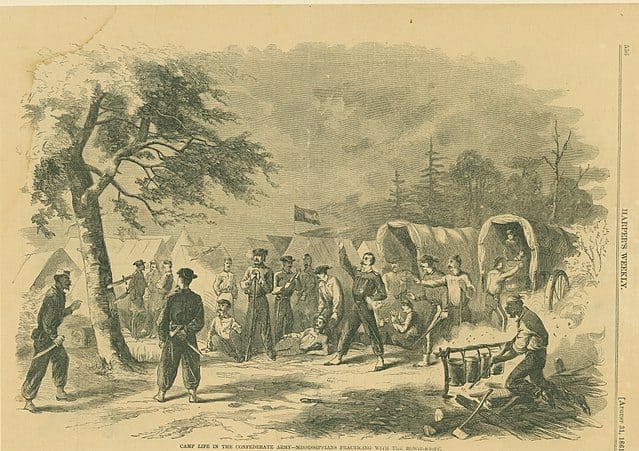
Most “Throwing Knives” Are Not Very Good!
Before I get into what the best throwing knives are, I feel the need to do a mini-rant. I checked out what some other websites listed as the best throwing knives. Pretty much all of them recommend the same knives. And those knives are mostly crap.
Why? The knives are either too small, too light, or both. Oh, and some sites recommend kunai throwing knives. Unless you are a nerdy anime fan, there is no reason to get a kunai (more on why kunai knives suck for throwing later).
I get that websites make affiliate money by recommending certain products. But they should at least do their research!
We also have affiliate links on this site, but we aren’t going to recommend products that are complete crap just to make money.
What Do We Recommend?
All the throwing knives listed here are larger in size and weight and are primarily center-balanced.
Cold Steel is the absolute best. They don’t break, even when thrown incorrectly.
But the other knives reviewed here are also suitable for beginners, especially on a budget.
Just know that you’ll eventually end up with some broken blades. By then, you’ll probably be ready to upgrade to a better set of throwing knives anyway.
Best Throwing Knives Overview
- Best for Complete Newbies (no-spin or rotational): Cold Steel Sure Flight Sport
- Best No Spin Knife: Cold Steel Pro Balance
- Best for Rotational Throwing: Boker Magnum Bo-Kri
- Best Low-Budget: Perfect Point PAK
Throwing Knife Reviews
Cold Steel Sure Flight Sport
Overall Length: 12″ | Steel: 1055 carbon | Weight: 8.3oz | Balance: Center
Cold Steel knives are by far the best when it comes to commercial throwing knives. They won’t break like other cheaper alternatives.
As for this Sure Flight knife, it is well balanced with a good length. This makes them suitable for beginners who aren’t sure whether they want to throw rotational or no-spin.
It is a bit lighter, so it won’t be as good for throwing long distances. However, while learning, the lighter weight will keep wrist strain down.
Note that this knife doesn’t come with a sheath. You’ll have to buy that separately. The sheath can hold up to three blades.
Best for: Rotational or no-spin; not great for long distances.
Cold Steel Sure Balance
Overall Length: 13¼” | Steel: 1055 carbon | Weight: 18.5oz | Balance: Slightly towards the handle
This is a favorite for no-spin spear-style throwing. It is a bit heavier than what is usually used for no-spin, but that gives it a good heft, so you don’t have to put as much force into it for the knife to fly far distances.
The center of balance is slightly towards the handle, which you want for no-spin. You can also add cordage over the handle to put more weight toward the handle.
As with all Cold Steel throwing knives, these are great quality and won’t break on you (at least not right away). Yes, they are pricier – but it’s cheaper to buy one quality knife than continually buy new knives.
The knife isn’t shaped completely straight. However, because it is smooth in design, it still works well for no-spin.
Best for: Best for no-spin throwing.
Boker Magnum Baily Ziel Throwing Knife Set
Overall Length: 13¼” | Steel: 420J2 stainless | Weight: 14oz | Balance: Center
Professional knife thrower John Bailey designed this knife set. They are great for beginners who want to get into competition. The knife will meet most competition rules.
The heavier weight makes them best for long-range throwing (though the weight might be a bit overwhelming at first if you are a newbie).
You won’t want to use these for no-spin throwing, though. The little spikes coming out of the middle of the blade will mess up the trajectory for no-spin. For rotational, though, they are great.
Another thing to note is that the knives are made of stainless steel. This isn’t the best material for throwing knives, and you’ll inevitably end up with some broken tips. You can just grab a grinder and fix the blades, though.
Best for: Rotational, long-distance throwing.
Boker Magnum Bo-Kri Throwing Knife Set
Overall Length: 10¾” | Steel: 420J2 stainless | Weight: 7.6oz | Balance: Center
Don’t let the odd shape of these knives discourage you. They have a great feel and are balanced, making calculating rotation easier.
The shape means they still rotate well even though they are lighter and shorter than most rotational throwing knives.
A lot of serious throwers swear by these. They recommend them for 1 rotation at 10 feet and ½ rotation at 12-14 feet. You can even get 1.5 and 2 spins out of them.
Another thing is that, despite being stainless steel, these knives hold up incredibly well. Sure, they will get some chips when they hit each other, but don’t break in half or snap like the cheap SOGs or Monarch throwing knives.
Best for: Rotational throwing, especially single rotation at 10 feet.
Perfect Point PAK Throwing Knife Set
Overall Length: 8.5″ | Steel: Stainless | Weight: 3.4oz | Balance: Handle-heavy when wrapped
These are great if you are looking for a great beginner knife set, especially for learning no-spin.
They are very cheap for a set of 12. Yes, that does mean the knives are a bit flimsy, and you will have some broken tips (buy a file to fix this!). But you won’t mind so much since the knives are so cheap.
Despite being so cheap, they are good throwers. The lighter weight and size make them less intimidating for newbies. They are smooth and balanced, so they are fairly easy to stick. You can even use them for rotational, but no-spin works better.
Note that they are really light. You’ll want to wrap the handle to add some more weight. Otherwise, the knives will bounce back instead of stick. Once you take the time to wrap them (which is very easy), the blades will stick so much better.
Don’t throw them unwrapped! They can bounce back quite fiercely, make a lot of noise, and it’s easier to break tips.
Best for: Best for learning no-spin or half-spin at distances of around 6-12 feet
United Cutlery Gil Hibben Competition Throwing Knife
Overall Length: 12″ | Steel: 420 stainless | Weight: 11.3oz | Balance: Center
These are one of the most popular and budget-friendly throwing knife sets. They have a great and well-balanced design. The weight and length make them ideal for rotational throwing, but you’ll be able to practice no-spin with them too.
The downside is that they do chip pretty easily. You’ll eventually have to grind them down. Some complain that the tip is too rounded, making the blade roll off the target instead of sticking. If you have a grinder, you can always adapt the shape of the tip.
Another issue is that these are slightly too small and light for most competition guidelines. However, the slightly lower weight (less than 1 oz per 1 inch) does make them less overwhelming for beginners.
Best for: Rotational, long-distance throwing but suitable for no-spin too
Schrade SCHF36
Overall Length: 10.4″ | Steel: Carbon | Weight: 12.3oz | Balance: Center
The Schrade SCHF36 Frontier knife isn’t marketed as a throwing knife. However, if you remove the handle, it is one of the best blades for throwing.
At 10.4 inches and 12.3 ounces, it is one of the few knives which exceeds the 1 oz per inch weight recommendation without going over 1.4oz-per-inch. Removing the handle will subtract some weight, but you can adjust this by wrapping the handle in linen and electrical tape (a favorite DIY handle of pro knife throwers).
The high-carbon steel is less likely to chip and break when thrown. Because the blade isn’t completely straight, getting the no-spin technique down with these knives will take some more practice. But, once you get it, you’ll love throwing with them.
Best for: No-spin at any distance
How to Choose a Throwing Knife
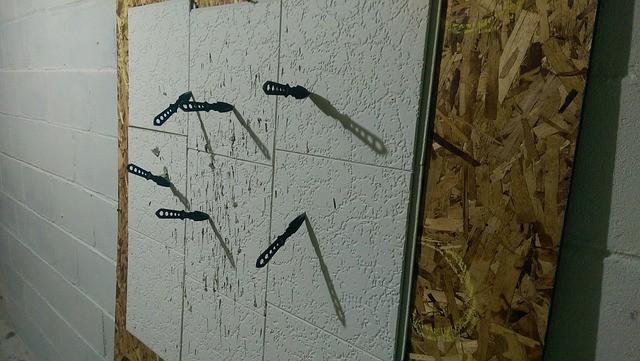
There’s always a lot to consider when choosing a knife. But even more so when you are selecting a throwing knife.
Specific design features can make it very difficult to throw a knife, especially if you are trying to throw it without spin. To make matters more complicated, many popular throwing knives do not meet competition guidelines!
Before you buy, these are the things you need to consider:
Contest Rules
If you think you’ll be competing, then look at the contest rules. Each contest has slightly different rules, but they generally have this in common about which knives are allowed:
- Minimum of 9-12 inches in length (tip to handle)
- Maximum of 16 inches in length (tip to handle)
- Three identical knives required
- Minimum weight of 8oz
- Knives that allow air to pass through the handle are not permitted
- Spears are not permitted. A spear is often defined as over 13″ with a point that makes up for less than 1/3 of the overall length
Ideal Length
It may seem counterintuitive, but longer knives give you better control – especially when aiming for faraway targets.
That’s why competitions usually require knives at least 12 inches for rotational throwing and 10 inches for no-spin.
As one knife thrower said of short throwing knives:
“I wish I had listened to a couple of folks who warned me against light and short knives when I started. I could have saved some dollars and lots of time by starting out with heavy knives 10″ or longer. They are just much easier to control and throw and they stick in more easily so you are picking less up off the ground.”
Why Choose Longer?
- When thrown rotationally (spin), they are easier to control because they turn slower. The longer the knife, the further the throwing distance is for each rotation.
- When throwing no-spin, the length gives much better control. The extra weight from the length will help it fly in an arc instead of spinning.
- Longer knives allow for a better grip.
- Heavier weight allows them to penetrate the target better
Best Knife Length per Throwing Style
- No-spin Russian style: 7-11 inches
- No-spin Mumyou-Ryu style: 9-13 inches
- No-spin Thorn style: 9.5-16 inches
- Rotational/Fixed distance: 12-16 inches
Weight
As Mike Bainton, founder of IKTHOF, said, heavier knives throw themselves. The weight of the knife means that it will leave your hand easier. The weight means they will stick to the target instead of bouncing back – a significant safety issue!
Again, it might seem counterintuitive, but heavier throwing knives are easier on your joints (when you first start throwing, you’ll find out how challenging this sport is on your joints!).
The weight means you don’t have to put as much force into the knife as you throw, thus saving your wrist and elbow from strain.
Note: Never use a light throwing knife (under 10 ounces) at close ranges (under 10 feet). It doesn’t happen often, but light knives can bounce back this far. You don’t want to lose an eye or toe! Which reminds me, never throw knives while wearing sandals!
So, How Heavy?
Many competitions have rules that the throwing knife must be at least 8oz. Expert knife thrower Harry McEvoy used this formula to determine the best weight for a throwing knife:
1-1.4 ounces per every 1 inch of knife
So, if your knife is 10 inches long, it should be at least 10 ounces in weight and a maximum of 14 ounces. As I ranted about earlier, most commercial throwing knives are nowhere near this heavy. That’s why champion knife throwers usually get custom blades.
Balance
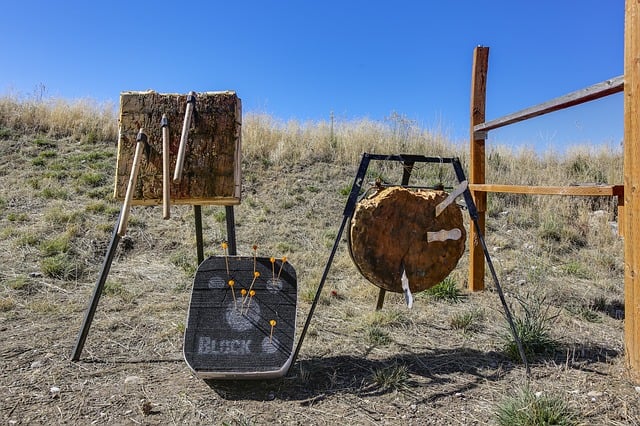
The balance of a knife refers to which part of the knife is heavier. A throwing knife will be blade heavy, handle heavy, or balanced (referring to center balance).
Many people think a throwing knife needs to be “perfectly balanced.” But a knife will rotate around its center of gravity when thrown. So, it’s just a matter of figuring out what that knife’s center of gravity is. That’s why we can throw very unbalanced things like tomahawks.
However, it is probably best to use a balanced knife when starting.
If the center of gravity is balanced, the knife will make nice circles when you throw it. Thus, it will be easier to predict the trajectory. Another reason to go with balanced knives is that you’ll be able to switch from one balanced knife to any other balanced knife. You can’t do this with handle-heavy or blade-heavy knives since each blade has its own feel.
*The rule is to grip the light end of the knife when throwing.
Blade Heavy Knives:
- The blade is heavier than the handle (such as a bowie knife)
- Are best thrown from the handle.
- Generally not preferred for throwing
- But good for beginners because they are easy to throw far.
Handle Heavy Knives:
- Are heavier at the handle than the blade
- Throws easier when gripped at the blade
- Good for learning no-spin.
- For rotational, good for low spin ratios (1.5-2)
- Requires a lot of skill to master
Balanced Blades:
- The blade and handle are balanced in weight
- Can be gripped by either the handle or the blade
- Good for rotational or for no-spin
- Best overall option for beginners
Handle – Good Or Bad?
No Handle Is Best
Most do not have a handle on them at all.
Why?
Because you want to grip a smooth, straight surface so you can get a good release when throwing it.
Any handle material (even the “durable” handles) will crack or break from repeated throwing. The only exceptions are Kraton and other types of rubbers. These can withstand a lot of impacts. However, you still probably want a throwing knife without a handle.
*You can always remove the handle from a knife to make it better for throwing.
Avoid Cutouts/Skeletonized Handles:
These may look cool, but the cutout can catch your palm as you throw. Further, if you want to compete, most contest rules prohibit knives with any openings that air can flow through.
Attaching Your Own Handle:
Many pro knife throwers will attach their own handles to their knives. One good option is to attach vulcanized cardboard. It is smooth and won’t cause friction as you throw the knife.
A more straightforward DIY solution is to use a strip of linen cut to about 1 inch wide. You wrap this around the knife handle, leaving a bit of steel exposed at the end. Then you go over the linen with electrical tape. The steel you left exposed is where you adhere the tape to. You’ll need to ensure that the last layer of linen and tape is UP on the handle.
Putting a DIY handle on your throwing knife will add some weight. The cool thing is that you can control how much weight you add to the handle, but you’ll need experience before figuring out just how much weight to add.
What Shape?
For beginners, the easiest knives to throw are very straight. These tend to be balanced, so they can be thrown from the handle or blade and are suitable for no-spin or rotational.
You can throw odd-shaped knives (and it can be enjoyable to do so!). You’ll just have to hold the knife further up or down to compensate for the odd shape.
Contrary to what you’d think, throwing knives do not need to be extremely sharp. All they need is a pointy tip. You also do NOT want the knife sides to be sharp. If the sides aren’t dull, take a file to them. Seriously – throwing knives bounce, and you don’t want to stab yourself!
Construction
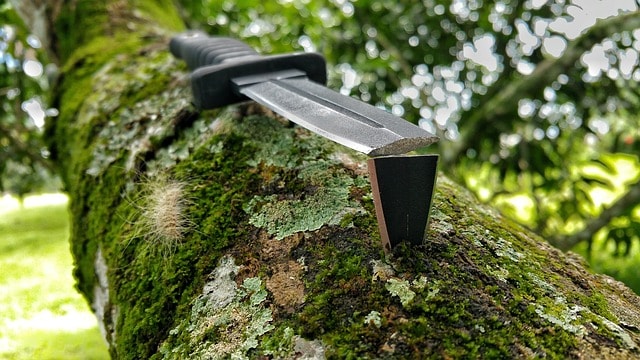
Most knives are not meant to take a lot of abuse. They will quickly break if used for throwing. Surprisingly, cheap knives usually don’t break when thrown. Instead, the tip often breaks off when you remove it from the target.
To make sure you are getting a knife that can withstand being thrown, look for:
- Full tang: It absolutely must be full tang. Otherwise, the handle will break off after a few throws.
- No perforations/cutouts/skeletonized parts: These will make the blade much weaker. I know skeletonized knives look cool, but they will break and be wasted money.
- Carbon steel: Carbon steel withstands throwing better than stainless steel. If carbon bends, you can just hammer it back into shape.
- Minimum 3/16 inches thick: This is a good guideline to ensure the knife is strong enough to withstand repeated throwing.
Avoid Kunai and Other Martial Art Knives/Daggers
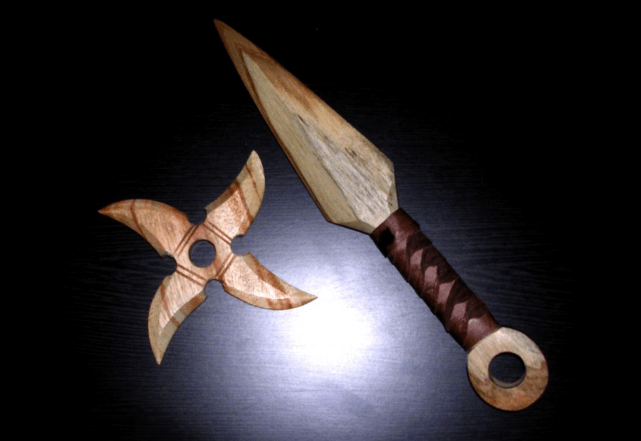
When you start looking, you will inevitably see a lot of Japanese-style knives for sale. These kunai knives were never meant to be thrown. Rather, they were used by the Japanese for gardening!
How did we come to think of them as throwing knives? Blame it on Kung Fu and Ninja movies.
Why kunai are terrible for throwing:
- Very short and lightweight: Good luck trying to stick these in the target! You’ll end up with a lot of knives bouncing back and possibly stabbing yourself. I hope you know how to treat a knife wound!
- The circle on the end of the handle gets in the way: This circle has no point for throwing. Sure, you could tie a rope to it and position two kunai at each side of a canyon to help you cross over, but how many times in your life are you going to need to do that!??
- They break: Almost all kunai knives are meant to be decorations for anime fans. They are cheaply built and will break if you try to throw them.
- Hard to control: Small, light throwing knives are hard to control and learn with.
Don’t let Hollywood and martial arts movies sway you. Don’t buy a Japanese style knife if you are serious about learning throwing.
No Spin or Rotational Throwing?
One of the things that you need to think about is whether you’ll throw no-spin or rotational. Some knives are better for one technique or the other.
Rotational Throwing (Spin)
- Easier to learn
- No special grip is needed
- Better for long-distance throwing
- Must throw from a precise, known distance or the blade won’t stick the target
- Requires you to know your knife really well (how many spins it will take to hit your target). Going from one knife to another with rotational can be difficult.
- Go with a balanced knife when learning rotational.
No-Spin Throwing
- Harder to master technique
- Can use a balanced knife or a handle-heavy knife
- No need to calculate how many spins per distance; can throw from any distance
- Better for close-range throwing
- Various throwing techniques to choose from
- Requires practice to get the grip right
- Faster than rotational throwing
You can see both techniques demonstrated in the videos below;
Throwing Knives for Self-Defense
Many people – especially in the prepper community – are interested in throwing knives for self-defense.
Sure, I like the idea of being such a good thrower that I could gauge an attacker’s eye by throwing a knife from 10 feet away.
But let’s be realistic here!
Knives used in combat are NOT thrown (yes, there are certainly some exceptions to this, but these are rare situations). Instead, you will use a firearm or pepper spray if you need to defend yourself at a distance.
You’d be foolish to throw a knife at the attacker. If you miss, you are left without a weapon. Even if you hit the attacker, there’s no guarantee it will stop them.
Throwing knives lack the mass and velocity to inflict severe damage. A person could continue to attack with the knife sticking out of his torso or arm. Worse, he could pull the knife out of himself and throw it at you!
The only time knives would be used in combat is for close-range attacks. Then, they wouldn’t be thrown. You’d sneak up on the enemy and stab them, not throw from a distance!
So, while it’s fun to enjoy those Hollywood knife-throwing scenes, don’t expect to use a throwing knife for self defense in real life!
Instead, look at these best knives for self-defense.
Do you throw knives? What’s your favorite knife for your style? Let us know in the comments.
https://www.knifethrowing.info/how-to-throw-a-knife.html
https://www.quora.com/Throwing-knives-is-no-spin-throwing-better-than-throwing-with-spin
https://www.quora.com/What-are-the-differences-between-a-throwing-knife-and-a-hand-to-hand-knife
https://trends.google.com/trends/explore?date=all&geo=US&q=knife%20throwing
https://www.nytimes.com/2017/09/15/sports/knife-throwing-sport.html
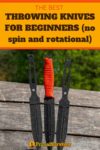



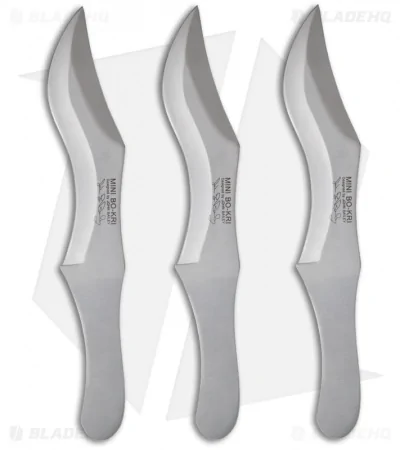





Good article, very precise and accurate.
For the beginners, I’ve Ben throwing knives for 40 years and I agree with everything written here. Especially about the Kuwaiti crap !
Also, watch out for the rebounds, they do happen.
The best written throwing article I’ve seen on Pinterest. Most of them are garbage and are trying to sell cheap knives. I agree with most of what you wrote. I disagree with this though. You said to avoid small, cheap knives and then you recommend one of the worst “throwers” available. Anything sold by Perfect Point is trash.
I’ve read a ton of articles about knife throwing. This is one of the best. Thank you.
Finally, somebody remembers Harry McEvoy! He’s throwing knives in heaven now & his son (who carried on the business) is retired; but you can still get Harry’s Tru-Bal design knives from Bobbie Branton’s Tru-Bal East company. They’re hand made exactly like Harry made them.
I got my set from Harry back in the 1970’s. I’ve thrown them for decades and they still work perfectly; I’ve taught dozens of people how to throw knives with them. The Pro Sport 79 throwing knives I just bought from Bobbie Branton are exactly the same as the set I got from Harry. Forget the rest, get the best!
Yes I throw knives and tomahawks knives I have SOG seal throwers ,S&W set of six , United Gill Hibbns another set of SOG with cutouts( my best throwers are the SOG seal pup no cutouts and I throw from the blade one rotation 9 to 11 ft ) thanks